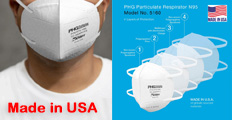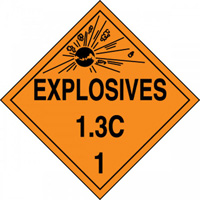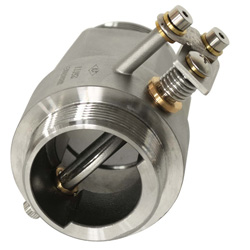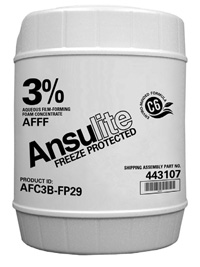



Find all of your laboratory and workplace safety supplies at Safety Emporium!
 Exothermic |
 Glossary Index |
 Eye Wash |
| MSDS Topics |
Free Sites | FAQ's | Regulations | Glossary | Software | Suppliers |
| Books | Forum | Poll | Fun stuff | Quiz | Store | |
| Understand your MSDS with the MS-Demystifier | Search ALL our MSDS info | |||||

Be sure you're in compliance with DOT placards and labels from Safety Emporium.
As an adjective, explosive refers to a chemical compound, mixture, device etc. that is capable of exploding. For example: "Gasoline forms an explosive mixture with air."
As a noun, explosive is a compound or mixture susceptible (by heat, shock, friction or other impulse) to a rapid chemical reaction, decomposition or combustion with the rapid generation of heat and gases with a combined volume much larger than the original substance.
Explosives can be broken into two general categories that reflect the rate of the transformation.

Vent your flammable storage safety cabinets safely with Safe-T-Vent thermally-actuated dampers from Safety Emporium.
A detailed discussion of explosives such as gunpowder, TNT etc. is outside the purview of this resource, but a few key points are worth mention, all of which follow from the cardinal principle of explosive safety, expose the minimum number of people to the minimum amount of explosive for the minimum amount of time. If you are working with explosives or potentially explosive materials (for example, in a laboratory setting using peroxides, azides, or other high-energy compounds), take the necessary precautions to limit the size/scale/scope of your work to the absolute minimum required. Be wary of potential spark and ignition sources such as electric outlets (use only Class 1 Division 1 explosion-proof electrical fixtures), static discharge, friction, exothermic reactions etc. and take proper precautions for storage and handling such as powder magazines, and safety enclosures.
A stunning example of laboratory work involving high energy materials gone wrong occurred at Texas Tech University in 2010, causing severe injuries to a graduate student worker that included the loss of three fingers. A US Chemical Safety Board case study of that incident provides useful lessons and recommendations for anyone working with similar materials.
Explosive can appear on Safety Data Sheets in a wide variety of contexts/
Flammable vapors can form explosive mixtures with air under certain circumstances. Accidental ignition by a spark, heat source or static electricity can trigger an explosion. These vapors can travel a significant distance from their source (along hallways and stairwells, for example), so always be sure to reduce or eliminate vapor formation whenever possible.
Some materials are shock-sensitive, meaning that they can be detonated (explode) merely by friction or touch. Examples include organic peroxides, nitrogen triiodide and dry picric acid. Such materials should only be dealt with by explosives-trained experts.
Other explosions can be caused by mixing incompatible chemicals. This is a common sort of laboratory accident (and one of the most terrifying).
Explosions can also be caused by over-pressurized containers. There is an utterly remarkable account of a large liquid nitrogen Dewar explosion at Texas A&M University that demolished a laboratory and rocketed through the concrete ceiling, leaving a perfect round hole. A similarly catastrophic incident occurred on a Texas highway in 2006 with a liquid oxygen cylinder. On a smaller scale, pressure can build up inside reaction vessels or containers if they are not properly vented, leading to catastrophic failure.
Never rely on the absence of a smell alone to indicate that propane or natural gas vapors are not present, particularly in a confined space. The odorants used in these gases can sometimes fade upon storage; see the entry on anosmia for more information on this phenomenon.

Safety Emporium sells MIL-SPEC fire fighting foam concentrates and other extinguishing agents.
See also: flammable, peroxide.
Additional definitions from Google and OneLook.
Entry last updated: Sunday, July 24, 2022. This page is copyright 2000-2025 by ILPI. Unauthorized duplication or posting on other web sites is expressly prohibited. Send suggestions, comments, and new entry desires (include the URL if applicable) to us by email.
Disclaimer: The information contained herein is believed to be true and accurate, however ILPI makes no guarantees concerning the veracity of any statement. Use of any information on this page is at the reader's own risk. ILPI strongly encourages the reader to consult the appropriate local, state and federal agencies concerning the matters discussed herein.